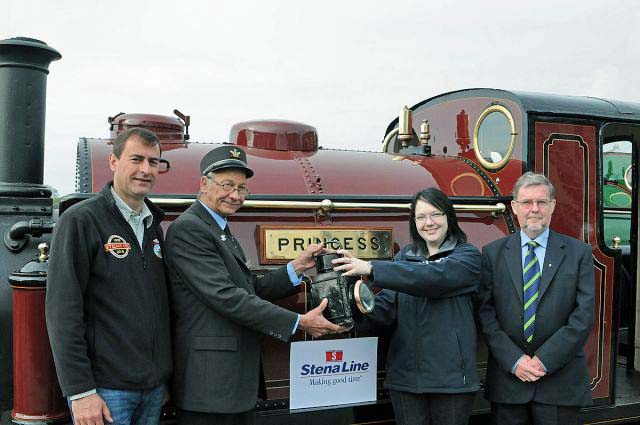

Princess is handed over to Irish Rail staff at Portmadog Harbour Station (Left, F&WHR General Manager Paul Lewin) - 4 May 2013 Photographer unknown.
28 May 2013 Princess on Display in Dublin
from 6 June 2013 In 1863 the Ffestiniog Railway began the use of steam locomotives built in London by George England, to haul trains of empty slate wagons from the harbour at Porthmadog to the quarries of Blaenau Ffestiniog.
They were named Prince and Princess, reflecting widespread public interest in the marriage of the Prince of Wales, the future Edward VII, to Princess Alexandra of Denmark.
Built barely more than 30 years after Stephenson's Rocket, the George England locos are the oldest surviving narrow gauge locomotives in the world. Remarkably, after 150 years, four of the six built still survive, two of them in regular use.
The Ffestiniog was the first railway in the world to adopt and make regular use of steam locomotives on a very narrow gauge, on a public railway, and over a significant distance. The introduction of these steam locomotives was a vital first step in the transformation of a well-engineered and well-run horse and gravity mineral railway into a state-of-the-art steam traction system worthy of emulation world-wide.
The technology and skills developed on the Ffestiniog were exported around the world and led to the proliferation of narrow gauge railways in other countries where inexpensive and cost-effective systems were required. The narrow gauge railways of France, India, the USA, Hungary, South Africa, Namibia, Venezuela, New Guinea, and Morocco, as well as industrial systems and those built in the trenches of the First World War, can all trace their roots back to a 13 mile line in North Wales.
Princess has been painstakingly restored by craftsmen at the Ffestiniog Railway and Irish Rail (Iarnród Éireann) have invited us to display the locomotive at Heuston Station in Dublin as part of Gathering Ireland 2013.
Princess will be unveiled on Thursday, 6 Jun 2013, remaining on display there for six weeks.
We are grateful to Stena Line for facilitating the ferry crossing to and from Ireland.
Author unknown.



Vancouver Island
British Columbia
Canada
| 

